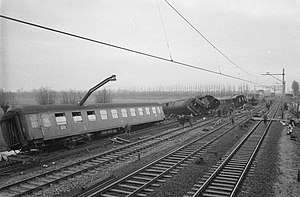Woerden train disaster
The Woerden train accident was a railway accident on 21 November 1960 at around 20:10 in Woerden, the Netherlands near the Cattenbroek rail crossing.
 | |
| Details | |
|---|---|
| Date | 21 November 1960 |
| Location | Woerden |
| Country | Netherlands |
| Incident type | Derailment |
| Cause | Ignoring temporary speed limit |
| Statistics | |
| Trains | 1 |
| Passengers | 151 |
| Deaths | 2 |
| Injuries | 3 (seriously) tens (minor) |
Incident
The train involved in the crash, a DM80760 / Fac BD, was a British train from Hanover, Germany to Hook of Holland, in the Netherlands, carrying 151 on leave British military personnel and their families, including some 10 women and several children.[1] The crash was due to the train driver failing to notice a temporary speed limit and travelling too fast through that section of track. The train broke behind the second carriage and six of the eleven carriages derailed and tilted partially. Two people died, three people were seriously injured and many more received minor injuries.[2]
Ambulances from surrounding towns (Zwammerdam, Woerden, Bodegraven and Utrecht) were summoned. The rescue operation was difficult because the site of the disaster was only accessible via a muddy country road. Initially, people had to be carried by stretcher several hundred metres to the ambulances, although the rescue was subsequently better organized.[3] Some military personnel helped during the rescue operation while others were sent to Woerden railway station. Around 100 Nederlandse Spoorwegen staff started the clear up with cutting torches. Hours after the disaster, the uninjured passengers were taken, by bus, to Gouda whence they were transported to Hook of Holland by train.
The tracks were blocked in both directions. The overhead lines were destroyed and the overhead supports had fallen onto the tracks. The clear up work continued through the night and the following morning, when rail cranes were able to lift some carriages back onto the track. The day after the crash, train traffic resumed on one track while the president of the Nederlandse Spoorwegen, ir. J. Lohman, also visited the disaster site.
Victims
One of the two people who was killed was Heinz Schmodta, a 62-year-old German cook. The other person was E. H. Miller, a 31-year-old British able seaman from Dunham. Just before the crash he went to the toilet in the fourth carriage and was crushed by the concertina effect. With the help of cutting torches his body was removed from the train.
The injured included a train guard, who was hurled out of the train.
Cause
Due to track works there was a temporary speed limit of 40 km/h which was indicated with special signs. According to statements, the train was travelling at a speed of 90 km/h at the time of the crash.
Gallery
.jpg) Woerden train disaster (1960)
Woerden train disaster (1960) One of the wagons
One of the wagons Cleanup work
Cleanup work
References
- De spoorwegramp te Woerden Leidse Courant, 22 November 1960 (pag 1)
- Jongerius, René (1993). Spoorwegongevallen in Nederland 1839-1993. Deel 22 in de boekenreeks van de NVBS (in Dutch). Schuyt & Co (Haarlem). ISBN 9060973410.
- Nederlands Instituut voor Beeld en Geluid (7 November 2013). "Vliegramp Franeker en treinongeluk Woerden op zelfde dag (1960)" – via YouTube.
External links
| Wikimedia Commons has media related to Woerden rail accident on 21 November 1960. |